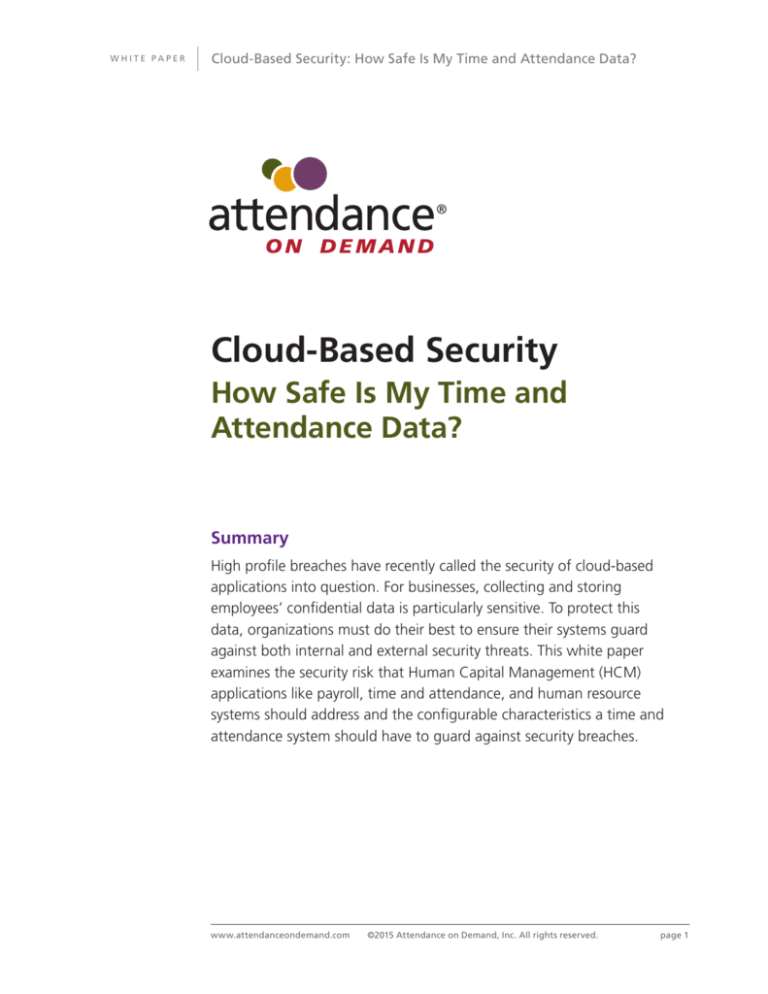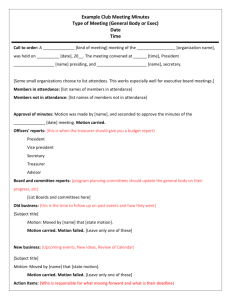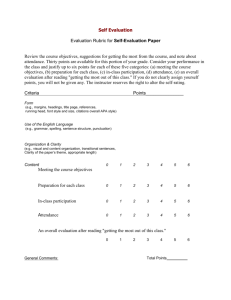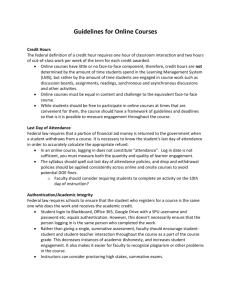
W HI T E PA PER
Cloud-Based Security: How Safe Is My Time and Attendance Data?
Cloud-Based Security
How Safe Is My Time and
Attendance Data?
Summary
High profile breaches have recently called the security of cloud-based
applications into question. For businesses, collecting and storing
employees’ confidential data is particularly sensitive. To protect this
data, organizations must do their best to ensure their systems guard
against both internal and external security threats. This white paper
examines the security risk that Human Capital Management (HCM)
applications like payroll, time and attendance, and human resource
systems should address and the configurable characteristics a time and
attendance system should have to guard against security breaches.
www.attendanceondemand.com ©2015 Attendance on Demand, Inc. All rights reserved.
page 1
W HI T E PA PER
Cloud-Based Security: How Safe Is My Time and Attendance Data?
Security Breaches in the Cloud
Although the benefits of cloud-based applications outweigh traditional desktop software in terms of safety, overhead, accessibility, updates and compatibility, recent
headline-making security breaches left many companies wondering just how safe
their data is in the cloud.
Stolen: 40 Million Target Customers’ Payment Information
In 2013, starting the day after Thanksgiving, popularly known as “Black Friday,”
through December 15, Target faced a massive hack that compromised more than
40 million customers’ payment cards. Experts now believe the hackers launched
the attack by stealing authentication credentials to the Target corporate network
from an HVAC subcontractor doing work for the large retailer, then uploaded
malware to Target cash registers designed to capture customers’ card information.
Bad press and consumer concern dogged the retailer through the holiday shopping
season, and Target may be held liable for not complying with the payment card
industry’s security standards.1
Hacked: Facebook, Google, Twitter, Yahoo, ADP
Simultaneously, a computer virus originating from the Netherlands hacked
2 million Internet accounts in early December, stealing more than 1.5 million
website login credentials (such as user IDs and passwords) and 320,000 email
credentials for high-profile sites such as Facebook, Twitter, Yahoo, Google,
LinkedIn and payroll service provider ADP.2 The virus targeted commonly-used
“dumb passwords,” including “123456,” “111111,” “admin,” and “password.” Affected
companies notified owners of compromised accounts and changed account passwords, but Trustwave, a cybersecurity group based in Chicago noted with interest
the inclusion of ADP among the social networking and email domains:
“It is only natural to have such domains [as the affected companies] in
the mix, but it is surprising to see [ADP] ranked #9 on the list. Facebook
accounts are a nice catch for cyber criminals, but payroll service accounts
could actually have direct financial repercussions.”3
News of these hacks left consumers—and businesses—understandably shaken.
Even as the Target investigation continues, many businesses are carefully
reviewing the security of their cloud-based applications to ensure data safety and
confidentiality.
The Drive for Data Security in Time and Attendance
Time and attendance data has the potential to be an Achilles heel for many businesses since it can include employees’ personal information. From Social Security
numbers and birthdates to medical leave and payroll information, HCM systems
are designed to deal in confidential data, making it important that these systems
feature critical security measures that can be configured to protect both employers
and employees from potential threats.
So what security features should businesses look for in a time and attendance
system?
www.attendanceondemand.com ©2015 Attendance on Demand, Inc. All rights reserved.
page 2
W HI T E PA PER
Cloud-Based Security: How Safe Is My Time and Attendance Data?
Guarding Against External—and Internal—Threats
To minimize the possibility of data hacking, the best time and attendance system
can be configured to limit access to confidential data and help protect it from both
external and internal threats. While the Internet hacking of Google, Facebook,
Twitter, Yahoo and ADP was purely an external attack, the Target breach investigation suggests the hackers infiltrated the retailer’s internal network to collect
customers’ payment information. Therefore, a time and attendance system must
have configurable security features to help protect data both outside and inside the
organization, including:
• Protection of Sensitive Information
Best practices for storing employees’ confidential information (such as Social
Security number, birthdate, pay rate or medical information) include storing it
in one place—where it is needed for calculations or identification—rather than
in multiple locations. For example, the employee’s Social Security Number and
birthdate are not needed in a time and attendance system. Instead, employees
can be identified by an assigned badge or ID number and can be sorted or
stored by employment characteristics (such as job, department, team or group).
• Restricted User Access
The system’s functionality and reporting capabilities are restricted according
to users. This ensures that employees at different levels can only access
information pertaining to themselves or their job responsibilities. The system
should allow restriction rights for at least three levels: employees with no
reports, supervisors, and payroll/HR administrators. Typically, employees will
only have access to their individual information. Supervisors need access to
both their individual information and the information of their direct reports
for department scheduling and reporting. Finally, payroll and HR managers
need broad access to both high-level and individual information and reporting
to assist in administrative tasks and organization oversight.
• Prompted Password Changing
The time and attendance system prompts users to change their password
regularly (and encourages responsible password creation) to reduce the risk of
password hacking. Ideally, passwords will be changed every 30–60 days. In
addition, it includes a system in case a password is lost or forgotten.
• Device Security
Physically-located system access points (such as kiosks or time clocks) and
mobile devices require additional security features to protect users. Time-out
values can be set to automatically log out users after a specified period of
time. The system can “register” mobile devices so that users cannot log in
on a device the system does not recognize. Also, time and attendance system
administrators can configure mobile device access to limit users to basic
features and functionality to protect the user in the event the device is stolen.
• Off-Site Data Centers
The benefit of cloud-based applications is that organizations can avoid the
overhead associated with storing their data locally. Instead, the cost of storing
the data is handled by the vendor as part of the organization’s usage subscription. However, it’s important to realize that data must be physically stored
www.attendanceondemand.com ©2015 Attendance on Demand, Inc. All rights reserved.
page 3
W HI T E PA PER
Cloud-Based Security: How Safe Is My Time and Attendance Data?
somewhere, and the storage facility must have security measures in place
to protect it. These include automated data backups and disaster recovery
plans in the event of prolonged power outages, flooding, fire or other natural
disasters.
With these security features, organizations can feel confident their data is
protected from internal and external security threats.
Conclusion: Time and Attendance Data Security
With the right safety features configured, cloud-based time and attendance
systems can be more convenient and secure than traditional software. Protecting
data from internal and external threats is critical to ensuring it is secure. This
gives organizations the access and flexibility needed in a time and attendance
system without compromising confidential data.
About Attendance on Demand, Inc.
Attendance on Demand supports the labor management needs of thousands
of companies and more than a half million employees across North America.
Launched in 2006, Attendance on Demand is a rapidly deployed, cloud-based
solution that minimizes a company’s risk and technology investment while
providing advanced features for securely managing labor data—calculating pay
rules, scheduling employees, budgeting labor, and automating recordkeeping for
labor law compliance. With standard uptime over the industry average of 99.995%
and above average customer retention rates, Attendance on Demand removes the
worry of maintaining expensive infrastructure. An extensive North American
distribution network helps organizations use Attendance on Demand to reduce
labor expenses and improve decision-making.
References
1 Krebs, Brian. “Target Hackers Broke in Via HVAC Company.” KrebsOnSecurity. 5 Feb 2014. Web. Accessed 17 Feb 2014. <http://krebsonsecurity.com/2014/02/
target-hackers-broke-in-via-hvac-company/>
2 “2 Million Internet Accounts on Facebook, Twitter, ADP, Others Hit By
Mass Hack on Dumb Passwords.” MarketWatch: The Wall Street Journal. 5
Dec 2013. Web. Accessed 17 Feb 2014. <http://blogs.marketwatch.com/
thetell/2013/12/05/2-million-internet-accounts-on-facebook-twitter-adp-others-hit-by-mass-hack/>
3 Chechik, Daniel. “Look What I Found: Moar Pony!” Trustwave SpiderLabs. 3 Dec 2013. Web.
Accessed 17 Feb 2014. <http://blog.spiderlabs.com/2013/12/look-what-i-found-moar-pony.
html#more>
To find out how Attendance
on Demand can help your
organization, call
800-465-9980 or visit
www.attendanceondemand.com
www.attendanceondemand.com ©2015 Attendance on Demand, Inc. All rights reserved.
Attendance on Demand is a registered trademark of Attendance on Demand, Inc.
page 4
12/13 rev 02/15







